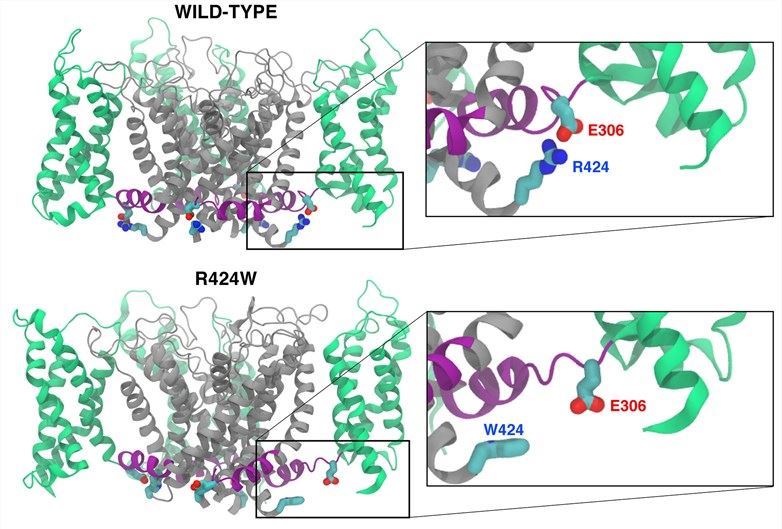CNGA3 is encoded by the CNGA3 gene and is also known as Cyclic nucleotide-gated cation channel alpha-3, Cone photoreceptor cGMP-gated channel subunit alpha, Cyclic nucleotide-gated channel alpha-3 or CNG channel alpha-3. It belongs to the Cyclic nucleotide-gated (CNG) ion channel family, which is a key mediator in signaling pathways of sensory and CNS neurons as well as in non-neuronal cells. Structural modeling with molecular dynamics and electrophysiological studies reveals that CNGA3 possesses six trans-membrane regions.
| Basic Information of CNGA3 | |
| Protein Name | Cyclic nucleotide-gated cation channel alpha-3 |
| Gene Name | CNGA3 |
| Aliases | Cone photoreceptor cGMP-gated channel subunit alpha, Cyclic nucleotide-gated channel alpha-3, CNG channel alpha-3, CNG3 |
| Organism | Homo sapiens (Human) |
| UniProt ID | Q16281 |
| Transmembrane Times | 6 |
| Length (aa) | 694 |
| Sequence | MAKINTQYSHPSRTHLKVKTSDRDLNRAENGLSRAHSSSEETSSVLQPGIAMETRGLADSGQGSFTGQGIARLSRLIFLLRRWAARHVHHQDQGPDSFPDRFRGAELKEVSSQESNAQANVGSQEPADRGRSAWPLAKCNTNTSNNTEEEKKTKKKDAIVVDPSSNLYYRWLTAIALPVFYNWYLLICRACFDELQSEYLMLWLVLDYSADVLYVLDVLVRARTGFLEQGLMVSDTNRLWQHYKTTTQFKLDVLSLVPTDLAYLKVGTNYPEVRFNRLLKFSRLFEFFDRTETRTNYPNMFRIGNLVLYILIIIHWNACIYFAISKFIGFGTDSWVYPNISIPEHGRLSRKYIYSLYWSTLTLTTIGETPPPVKDEEYLFVVVDFLVGVLIFATIVGNVGSMISNMNASRAEFQAKIDSIKQYMQFRKVTKDLETRVIRWFDYLWANKKTVDEKEVLKSLPDKLKAEIAINVHLDTLKKVRIFQDCEAGLLVELVLKLRPTVFSPGDYICKKGDIGKEMYIINEGKLAVVADDGVTQFVVLSDGSYFGEISILNIKGSKSGNRRTANIRSIGYSDLFCLSKDDLMEALTEYPEAKKALEEKGRQILMKDNLIDEELARAGADPKDLEEKVEQLGSSLDTLQTRFARLLAEYNATQMKMKQRLSQLESQVKGGGDKPLADGEVPGDATKTEDKQQ |
CNGA3 is a novel effector of NO/cGMP signaling in nociceptive processing. It is expressed in inhibitory dorsal horn neurons of the spinal cord and in non-neuronal DRG cells. The nociceptive behavior of CNGA3-deficient mice suggests that CNGA3 mediates inhibitory effects during inflammatory pain. The inflammatory pain behavior of CNGA3−/− mice differed from that of WT mice after injection of formalin or zymosan into a hindpaw, suggesting that CNGA3 might play a particular role in nociceptive processing and during inflammation. Moreover, CNGA3 contributes to the inhibitory effects of cGMP because CNG channels containing CNGA3 in retinal cones are activated by low micromolar concentrations of cGMP. In addition, CNGA3 has a direct role in local regulation of synaptic structure or function, as CNGA3 is localized to COSs and absent from photoreceptor terminals. CNGA3−/− mice developed an exaggerated pain hypersensitivity induced by intrathecal administration of cGMP analogs or NO donors, suggesting that CNGA3 contributes in an inhibitory manner to the central sensitization of pain pathways during inflammatory pain as a target of NO/cGMP signaling.
 Fig.1 Side view of CNGA3 homotetramer model (Tanaka, 2015).
Fig.1 Side view of CNGA3 homotetramer model (Tanaka, 2015).
This article provides evidence that CNGA3 has involved in the inhibition of the central sensitization of pain pathways during inflammatory pain as a target of NO/cGMP signaling.
This article suggests that the sensitivity of cone CNGA3 channels is regulated by phosphoinositides and the aberrant channel regulation contribute to disease progression in patients with the CNGA3 L633P mutation.
The evidence of this article supports that CNGA3 is expressed in inner ear hair cells and its binding partner EMILIN1 (and β1 integrin) and cGMP-specific PDE6C are potentially replicated in cochlear outer hair cells.
This article demonstrates that mice with cone CNGA3 channel deficiency result in the secondary rod impairment and degeneration after cone degeneration and the loss of cone phototransduction accompanies the compromised integrity of cone terminals.
This article reports that two novel mutations of CNGA3 are specifically expressed in cone photoreceptors. Re-evaluation of the clinical status revealed that both families with the two mutations have achromatopsia.
To obtain the soluble and functional target protein, the versatile Magic™ membrane protein production platform in Creative Biolabs enables many flexible options, from which you can always find a better match for your particular project. Aided by our versatile Magic™ anti-membrane protein antibody discovery platform, we also provide customized anti-CNGA3 antibody development services.
As a renowned player as well as a leading custom service provider in the field of membrane protein, Creative Biolabs has been establishing a strong network of our worldwide customers for successfully accomplishing numerous challenging projects including generation of many functional membrane proteins. Please feel free to contact us for more information.
Reference
All listed services and products are For Research Use Only. Do Not use in any diagnostic or therapeutic applications.